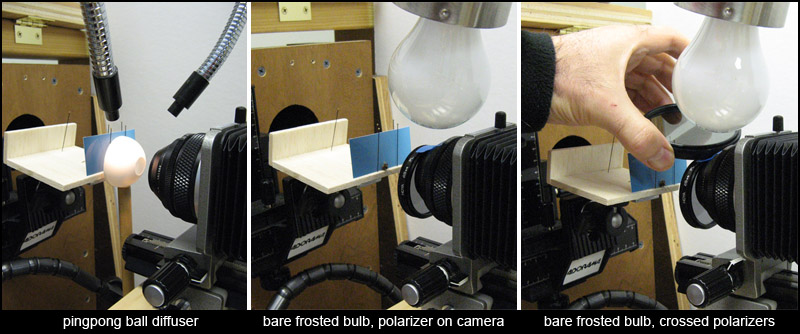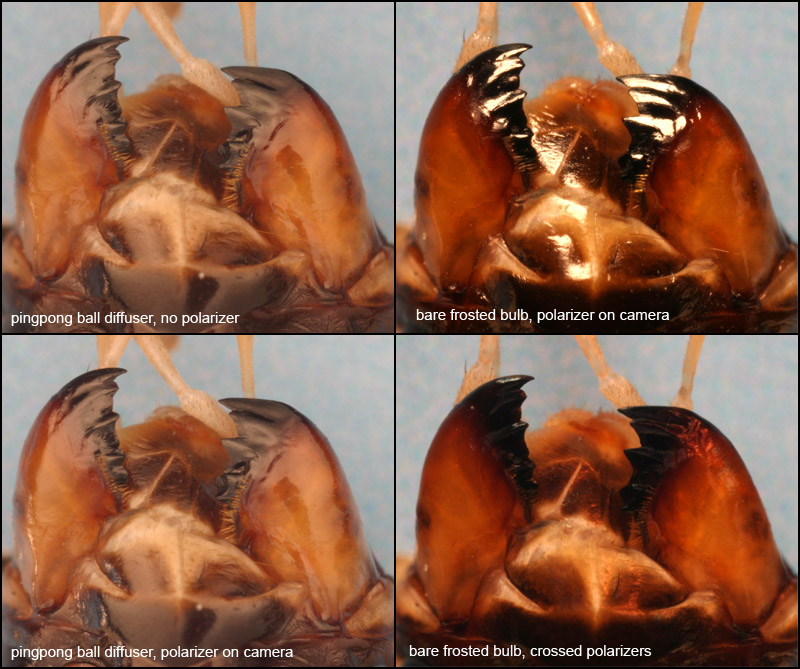....
What, you're back already?! Excellent. Then you've already read a bit of discussion about the effect of polarizers on this picture, and you can guess that I'm going to fill in some details.
To start, here are pictures of a couple of lighting setups. On the left is the pingpong ball diffuser like what produced the original photo. (It's been torn down and set up again a couple of times, so please don't expect exact repetition here.) The right two are bare-bulb setups that yield lousy pictures but good insight. (BTW, the cricket is lying on its back, with its neck sticking through a notch in the blue card.)

Using these lighting setups, I shot a series of pictures to document what happens with different arrangements of polarizers.
The following four cases show all the important effects:
- pingpong ball diffuser, no polarizer
- pingpong ball diffuser, polarizer on camera
- bare bulb lighting, polarizer on camera only (between subject and lens), and
- bare bulb lighting with crossed polarizers -- one between the light bulb and the subject, the other between the subject and the lens as usual.

Nope, there is no mistake here -- I shot the series twice and checked very carefully to be sure that I had not mixed up any images.
It should be obvious that when using the pingpong ball diffuser, putting a polarizer on the camera has very little effect. The glare in some areas is reduced slightly (top of left mandible), while the glare in other areas is increased slightly (left side of left mandible). But the differences are small -- you have to study to see them.
I'm not showing the picture here, but that same thing is true with the bare bulb setup -- putting a polarizer on the camera alone has very little effect.
On the other hand, the effect of crossed polarizers is dramatic. The intense specular reflections essentially disappear, leaving a richly colored dark shape that shows a distinct outline but no surface contouring or details.
This demonstration simply begs for explanation, and I hope it's not too difficult to write one. Here goes...
Think of a ray of light as a vibrating string. Just like vibration in an ordinary string, vibration in light has a direction -- it can be up-and-down, side-to-side, or any angle in between. (It can even spin, but we're going to ignore that case here.)
In ordinary non-polarized light, the vibrations occur at all different angles. In completely polarized light, the vibrations occur at only a single angle. You can also have partially polarized light, in which the vibrations are larger at one angle than others.
Starting with ordinary non-polarized light, there are three ways to make it polarized.
One way to polarize light is to run it through a polarizing filter, which you can think of as a sort of screen that blocks light vibrating across the axis of the screen, while passing light that vibrates along the axis. A good polarizing filter produces almost completely polarized light, blocking 99% or more of any light that vibrates across the axis.
The second way to polarize light is to reflect it off a shiny surface made of most materials (metals excluded). This method generally gives only partially polarized light, and the amount of polarization depends on the angle of reflection. There is a critical angle, called Brewster's angle, at which the reflected light is 100% polarized. That angle varies with the material; for water it's about 37 degrees away from the water surface. At angles greater or less than Brewster's angle, the polarization is less than 100%. At 90 degrees, the polarization is zero.
The third way to polarize light is to scatter it in certain ways. Blue sky is partially polarized. The amount of polarization varies with angle away from the sun; it reaches a maximum (still much less than 100%) at 90 degrees.
Now, it is also possible to turn polarized light back into non-polarized. The easiest way to do that is to shine polarized light on most anything non-metallic. Light that is reflected in a non-specular manner will also be non-polarized, regardless of the polarization (if any) of the illumination.
On the other hand -- and this is important -- specular reflections from any material retain the angle of polarization of the illumination. In addition, specular reflections also retain the color of the illumination, not the substrate. That's why glare is always "white" and thus reduces color saturation.
OK, with all that background, we're now prepared to explain what we see in the pictures.
With the pingpong ball diffuser, the illumination is completely non-polarized. The specular reflections that comprise glare become slightly polarized, but only very slightly because most of the light in this setup comes from in front of the subject and the angles of reflection are far away from Brewster's angle. Putting a polarizing filter on the camera diminishes some of the glare spots while enhancing others (depending on the orientation of the surface that generates them). But because none of the reflections are strongly polarized, the filter really doesn't make much difference.
The same thing is true with the bare bulb -- putting a polarizing filter on just the camera does not have much effect. (In fact it has so little effect that I'm not even bothering to show it.)
However, size and placement of the bare bulb also permits a second polarizing filter to be used, this one placed between the bulb and the subject. Properly oriented, that second filter makes all the difference in the world!
What happens then is that the illumination becomes essentially 100% polarized. Every specular reflection -- every bit of glare, no matter how small -- preserves that polarization and thus can be blocked by the polarizer on the camera when turned to the proper angle. On the other hand, non-specular reflections from this non-metallic subject are also non-polarized, so they do not get blocked by the polarizer on the camera, no matter what angle that polarizer is turned to.
The upshot is that by polarizing the illumination, you can dial in exactly the amount of glare reduction you want, by adjusting the angle between the two polarizers. In the fourth panel above, I have set the polarizers to be at 90 degrees, eliminating essentially all of the glare.
OK, great, so now we have an explanation for what's happening with the cricket mandibles.
But why does this differ so much from Irwin's experiences with his subjects? Why do I need glare to reveal shape with the cricket mandibles, but he doesn't with his plants?
Most likely there are several contributing factors. I suspect the two most important are these:
- The materials are different. Most plant structures, and for that matter most insect structures, are essentially opaque and produce their non-specular reflections at or very near the surface. In that case, the non-specular reflections carry much (not all) of the same shape information that the specular ones do. These mandibles are different, though. They are essentially clear but absorbant -- a lot like the coffee I mentioned in the other post -- so there is very little shape information contained in the non-specular reflections.
- The lighting angles are different. In many setups used with larger subjects, a lot of light comes from behind the subject. That light reaches the camera through an angle of reflection that is closer to Brewster's angle, causing the specular "glare" component to be much more strongly polarized and thus able to be blocked. With these tiny macro setups, it's physically challenging to hold everything in place while providing light from both front and back. Usually I go with just one or the other.
The answer is, I'd love to but I haven't figured out how to pull that off yet. The trick is to either 1) polarize the fiber output and then scatter the light without changing its polarization, or 2) diffuse the light first and then polarize it before it gets to the subject. Both of these seem harder than trivial, but on the other hand, I haven't spent any time on them either. Could be there's some clever but simple approach, in which case I'd be delighted to hear about it.
A long writeup, but worth it, I think. At least I've got the content straight in my head now.
Questions, comments?
--Rik
